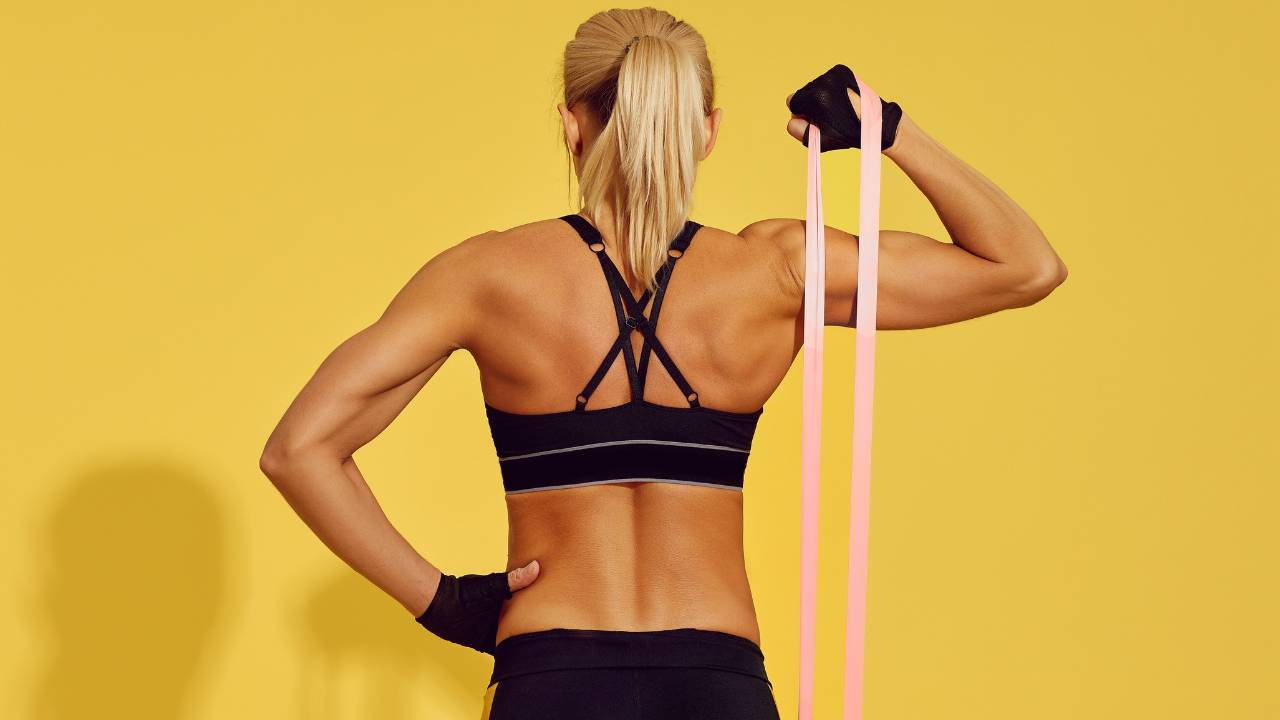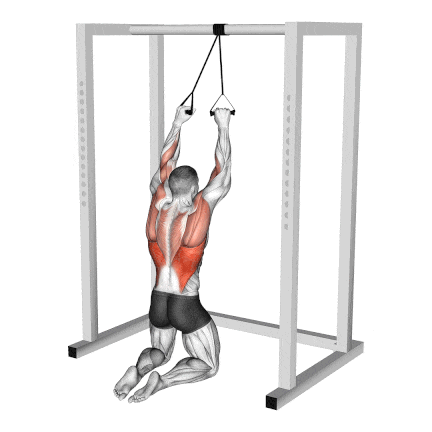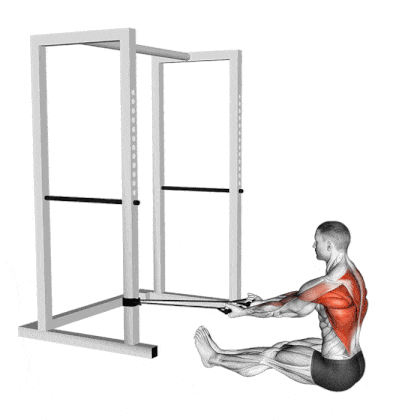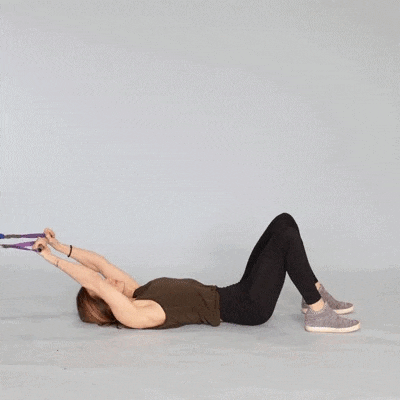Have you noticed how many people completely intensify their lat training using resistance bands?
I get it.
When you think lat exercises, your mind probably jumps straight to Barbell row and heavy cable rows.
And sure, those exercises are golden… if you have access to a fully loaded gym.
But here’s the thing:
After testing literally hundreds of resistance band exercises (and spending way too many hours analyzing the research), I’ve found that bands can help you build your lats.
Today, I’m going to show you exactly how to do these exercises, the science behind why they work, and a done-for-you workout plan that combines them.
Let’s dive in.
Want to take your gains to the next level? Discover your daily calorie needs with our free TDEE calculator

- 1. Resistance Band Lat pulldown
- How To Do
- 2. Resistance Band Bent Over Row
- 3. Seated Resistance Band Row
- How to Do
- 4. Band Straight Arm Pulldown
- How To Do
- 5. Band Pullover
- How To Do
- Resistance Band Back Workout Routine For Beginner
- Band Back Workout Routine
- Conclusion
- Know More Resistance Band Exercises
- References
1. Resistance Band Lat pulldown
One of the standout features of the resistance band lat pulldown is its convenience. Unlike traditional lat pulldown machines, resistance bands are portable and can be used at home or while travelling.
And create what I call ‘ascending resistance’ – the more you pull, the harder it gets.
It is a compound exercise that engages multiple muscle groups of the back, specifically the latissimus dorsi (lats) and teres major.
There are some best variations of the band lat pulldown that you can add to your back workout.
- Close-grip pulldown: Hold the resistance band with a closer grip. This will target the inner lats more.
- Wide-grip lat pulldown: Wide grip will target the outer lats more.
- One-arm pulldown: Work on each part separately and make your weaker side as strong as your stronger side.

How To Do
- Secure your band to an overhead position like a door anchor, pull-up bar, or even a sturdy tree branch. Pro tip: Give it a few test pulls – if it feels sketchy, it probably is.
- Grab the band with an overhand grip, slightly wider than shoulder width.
- Step back or (kneel down) until you feel tension in the band (about 2-3 feet), and create the “power lean” – a slight backward angle with your torso.
- Pull the band down to your upper chest like you’re trying to crack a walnut with your armpits. Seriously. This cue instantly activates your lats.
- Then, hold your shoulder blades together for a second, like you’re trying to hold a pencil between them.
- Slowly release the tension and return to the starting position. Control the return like you’re doing a negative rep with weights.
- Do 3-4 sets of 10-12 repetitions of resistance band lat pulldowns.
2. Resistance Band Bent Over Row
The band bent-over row is a popular compound exercise that targets the upper back muscles, including the lats, rhomboids, trapezius, and latissimus dorsi. It also works your arms and core muscles.
Because bands provide resistance in multiple directions (try that with a barbell), you’re forced to control the weight both horizontally AND vertically. This creates a unique type of muscle tension that’s practically impossible to replicate with free weights.
Other variations of a band bent over rows that you must try:
- Single-Arm Resistance Band Rows: This variation trains the back muscles unilaterally. Means better mind-muscle connection.
- Underhand Grip Resistance Band Rows: Switching to an underhand grip targets your biceps and lower lats.

How To Do
- Center the band under your feet, about hip-width apart. This width isn’t random—it creates the perfect base for maximum force production.
- Hinge at your hips like you’re trying to touch a wall behind you with your butt. Your torso should be almost parallel to the ground.
- Grab the handles with a neutral grip (palms facing each other). Let your arms hang like ropes, which will create a lat activation zone.
- Drive your elbows back like you’re trying to elbow someone behind you. Focus on squeezing your shoulder blades together at the top.
- Slowly straighten your arms to return to where you started.
3. Seated Resistance Band Row
Research indicates that resistance bands are effective for targeting the back muscles and significantly improve muscular strength across various populations.
Unlike bent-over rows, band rows let you manipulate the band’s angle of resistance in ways that other exercises can’t touch.
Other ways to build bigger and stronger lats at home with band over rows.
- Seated resistance band row: It is a great option for beginners or those with limited mobility. It is also an excellent choice for targeting the upper lats.
- Standing resistance band row: It is a more challenging variation that targets the entire back muscles.
- Kneeling resistance band row: This variation involves a half-kneeling or full-kneeling position. Reducing assistance from the lower body can help isolate the upper back muscles.

How to Do
- The seated row with resistance bands is virtually identical to the horizontal row performed in the gym with a pulley machine.
- The only notable difference is that your feet will be placed in front of you on the floor instead of against the angled foot plates of a machine.
- Double up a rubber band (choose one that allows you to perform a full movement).
- Grasp each end with one hand.
- Place the elastic around a fixed anchor point, or on your feet (shoes are recommended).
- Keep your legs straight and contract your abdominal muscles.
- Pull the band toward your belly button until your elbows are beyond the back of your body.
- Slowly return to the starting position while controlling the elastic. Repeat as many times as necessary.
4. Band Straight Arm Pulldown
It is a variation of the classic lat pulldown exercise and is performed standing with the elbows locked out the entire time.
The straight arm position creates what I call the “mechanical advantage paradox.” When you keep your arms straight, you’re actually forcing your lats to do ALL the work.
No help from your biceps. No assistance from your rear delts. Just pure lat engagement.
You can adjust the resistance by gripping the band closer together (increased resistance) or wider apart (reduced resistance).

How To Do
- Secure the resistance band overhead or at a high anchor point.
- If you don’t have an anchor point, you can hold the band stretched overhead with both hands.
- Hold the band ends or handles with both hands, palms facing down.
- Stand tall with feet shoulder-width apart. Avoid excessive arching in the lower back as you pull down.
- Extend your arms straight up overhead, ensuring there’s tension in the band.
- Keep your arms straight and pull the band ends down to your thighs.
- Pause at the bottom of the movement, then slowly lower the band back to the starting position.
5. Band Pullover
Unlike every other lat exercise, pullovers let you target your lats without your biceps taking over. It’s practically impossible to cheat this movement. Either your lats do the work, or the movement doesn’t happen.
The pullover hits your lats in their lengthened position, creating “stretch-based hypertrophy.” Research shows this type of training can literally supercharge your muscle growth.

How To Do
- Anchor the resistance band securely at a low point.
- Lie down on a flat bench or on the floor. Ensure that your back remains firmly in contact with the ground.
- Hold the handles of the band in each hand and bend your elbows slightly.
- Move your arms backward, following a semi-circular path.
- Slowly bring the handles back together over your chest to return to the starting position.
- Repeat for 10-12 reps.
Resistance Band Back Workout Routine For Beginner
| Exercise | Sets | Reps | Rest |
|---|---|---|---|
| Standing Band Row | 3-4 | 8-10 | 60–90 sec |
| Band lat Pulldown | 3-4 | 8 | 60-90 sec |
| Band Pullover | 4 | 8-10 | 60-90 sec |
Band Back Workout Routine
| Exercise | Sets | Reps | Rest Time |
|---|---|---|---|
| Band Lat Pulldown | 3 | 12-15 | 45-60 Sec |
| Band Seated Row | 3 | 10-12 | 45-60 Sec |
| Band Straight Arm Pulldown | 3 | 12-15 | 45-60 Sec |
| Band Face Pull | 3 | 10-12 | 45-60 Sec |
| Band Pull Apart | 2 | 15-20 | 45-60 Sec |
Conclusion
Let’s wrap this up.
After testing these exercises with hundreds of clients, here’s the bottom line: These band exercises will build serious lat development if you nail three fundamental principles:
- Progressive tension: Use bands you can control for 8-12 clean reps
- Perfect for: Follow the detailed tutorials above
- Smart programming: Stick to the workout plan provided
Need Help? If you’re unsure about the form:
- Record yourself
- Compare against the tutorials
- Watch for the common mistakes highlighted above
Got Questions? Drop them in the comments below. I personally respond to every question.
This post is worth bookmarking – you’ll want to refer to the form tips and workouts as you get better.
Know More Resistance Band Exercises
- Best Resistance Band Chest Exercises
- Resistance Band Back Workouts
- Best Resistance Band Shoulder Exercises
- Resistance Band Trap Exercises
- Best Resistance Band Tricep Exercises
References
- Lopes JSS, Machado AF, Micheletti JK, de Almeida AC, Cavina AP, Pastre CM. Effects of training with elastic resistance versus conventional resistance on muscular strength: A systematic review and meta-analysis [published correction appears in SAGE Open Med. 2020 Sep 9;8:2050312120961220]. SAGE Open Med. 2019;7:2050312119831116. Published 2019 Feb 19. doi:10.1177/2050312119831116.
- Schuler, Lou., Mejia, Michael. Pp. 167 “Upper Back” “The Men’s Health Home Workout Bible: Over 400 Exercises No Gym Required”. United States: Harmony/Rodale, 2002.
- Bergquist R, Iversen V, Mork P, Fimland M. Muscle Activity in Upper-Body Single-Joint Resistance Exercises with Elastic Resistance Bands vs. Free Weights. Journal of Human Kinetics. 2018;61(1): 5-13. https://doi.org/10.1515/hukin-2017-0137
- Jeno SH, Varacallo M. Anatomy, Back, Latissimus Dorsi. [Updated 2022 Apr 5]. In: StatPearls [Internet]. Treasure Island (FL): StatPearls Publishing; 2022 Jan-. Available from: https://www.ncbi.nlm.nih.gov/books/NBK448120/

Manish is a NASM-certified fitness and nutrition coach with over 10 years of experience in weight lifting and fat loss fitness coaching. He specializes in gym-based training and has a lot of knowledge about exercise, lifting technique, biomechanics, and more.
Through “Fit Life Regime,” he generously shares the insights he’s gained over a decade in the field. His goal is to equip others with the knowledge to start their own fitness journey.
